사진 (sajin) — Photos
Oh hello. The other day a guy from Korea Telecom came over to my apartment and at long last hooked me up with a reliable internet connection. This means that I can finally upload all the photos that I’ve taken over the last month. Remember, you can click on any one and see it far larger.
Let’s start off with a few photos that I took in more or less random directions when I got into Seoul. I thought it’d be a good idea to get pictures of what the general feel of the city is like, since every city looks a little bit different. So here’s a flavor of Seoul:
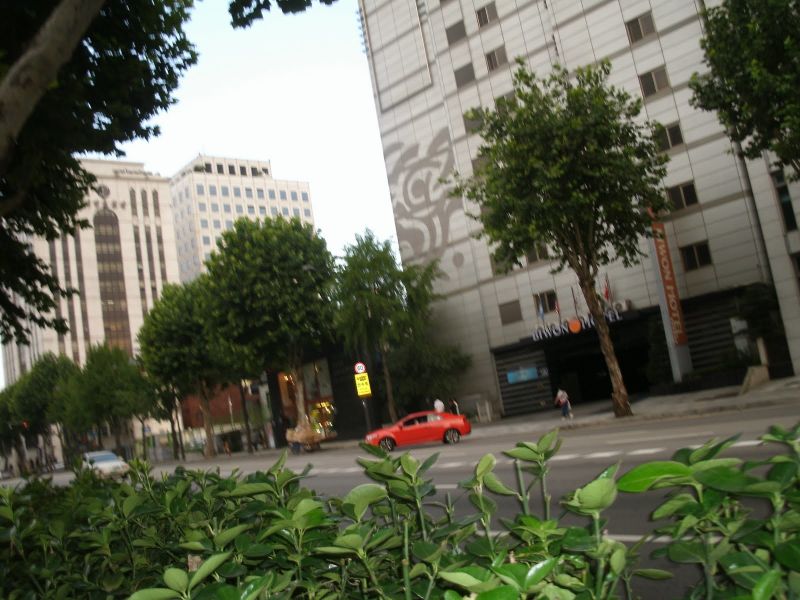
This street is not typical. Most of the time, there’s no empty space on the roadway. I think this was an abnormally spacious district.
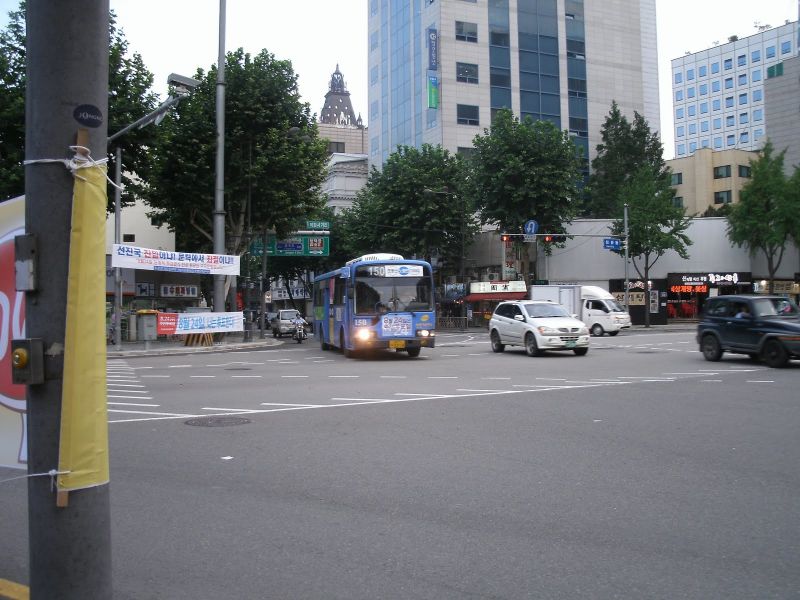
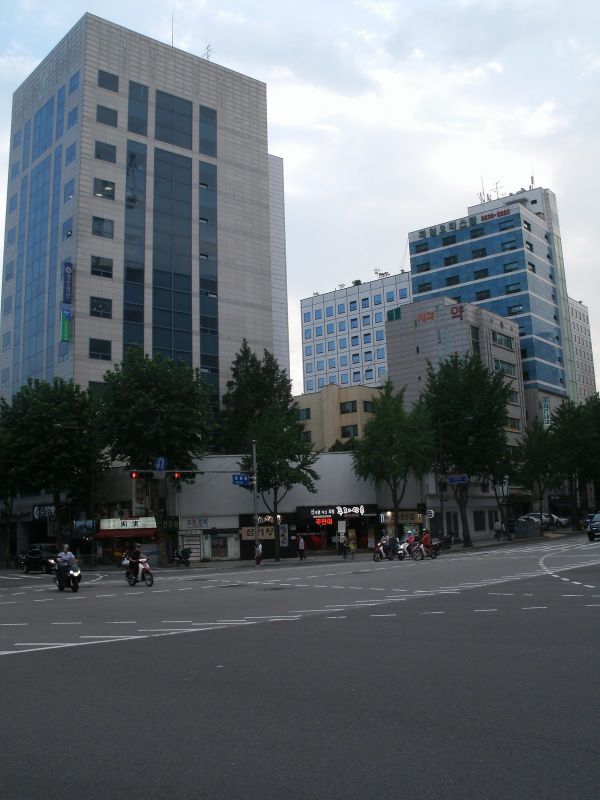
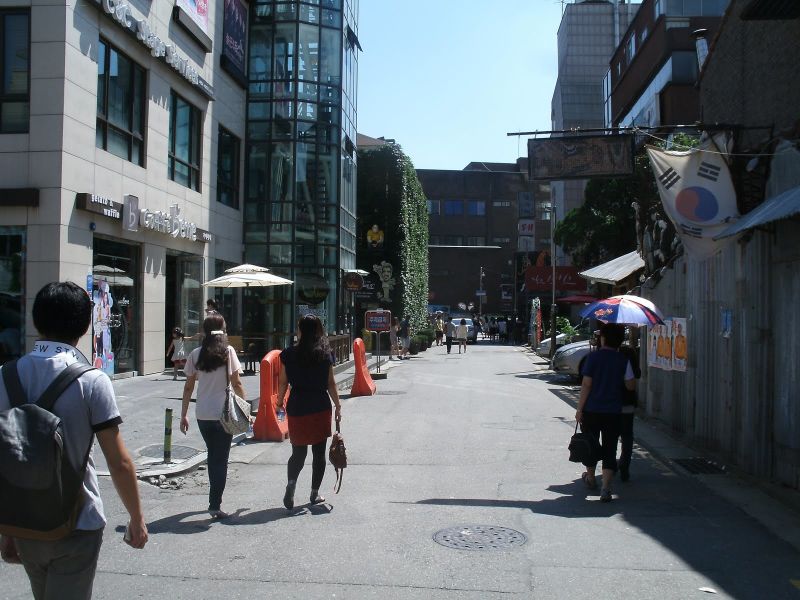
Some of us just took a walk around our neighborhood to try and find a bookstore, and on our way we happened upon this. It’s not the sort of thing one is likely to see in, say, Davenport.
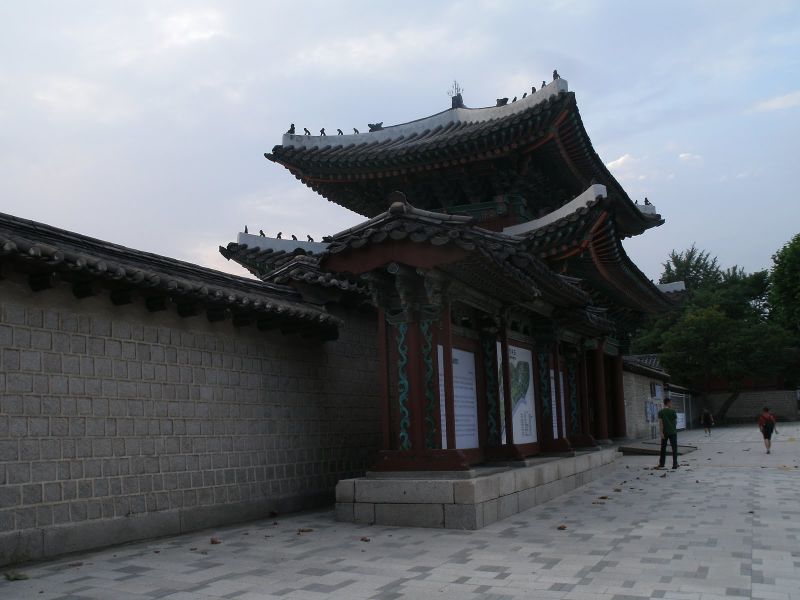
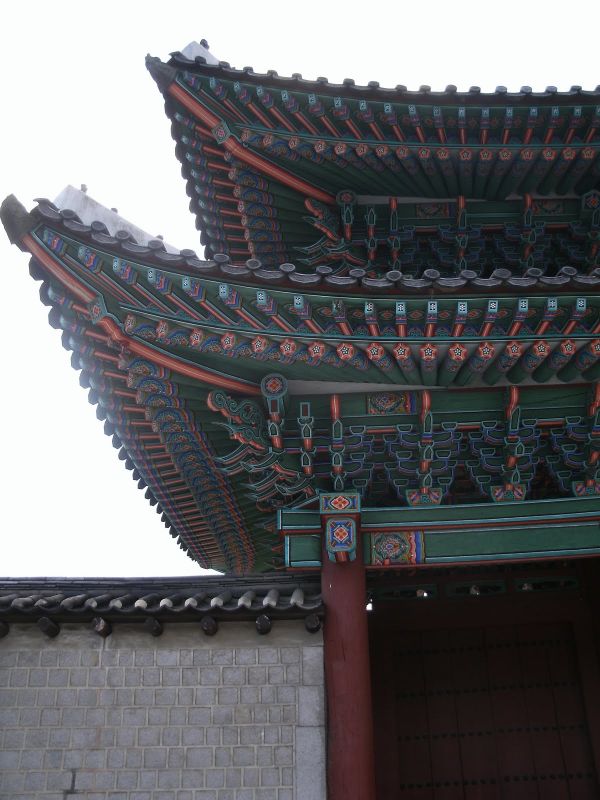
Walking in unplanned directions, we happened by the neighborhood artificial leg shop.
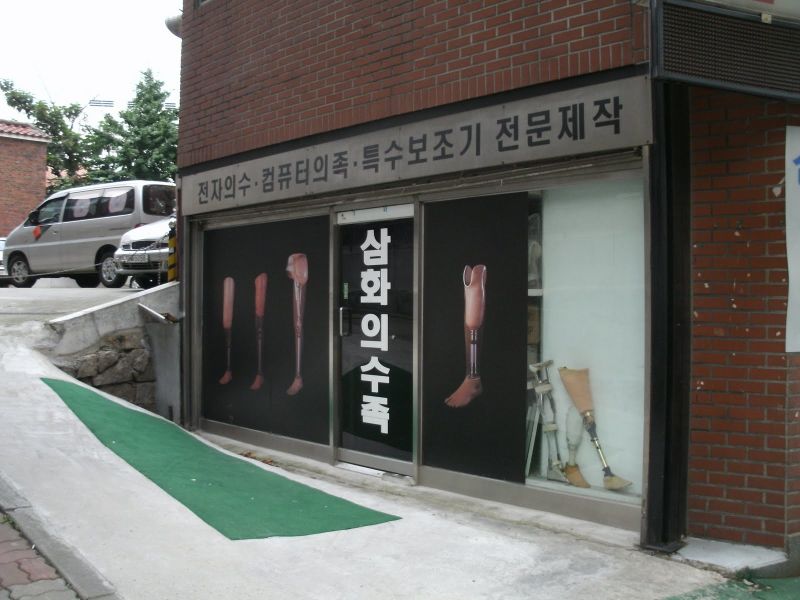
I wanted to take a picture of just this traditional carving, but there was modern stuff all around it, and I realized it would have to be a picture that shows the juxtaposition between the deep old culture of Korea and the streamlined, commercial culture it has in the modern era.
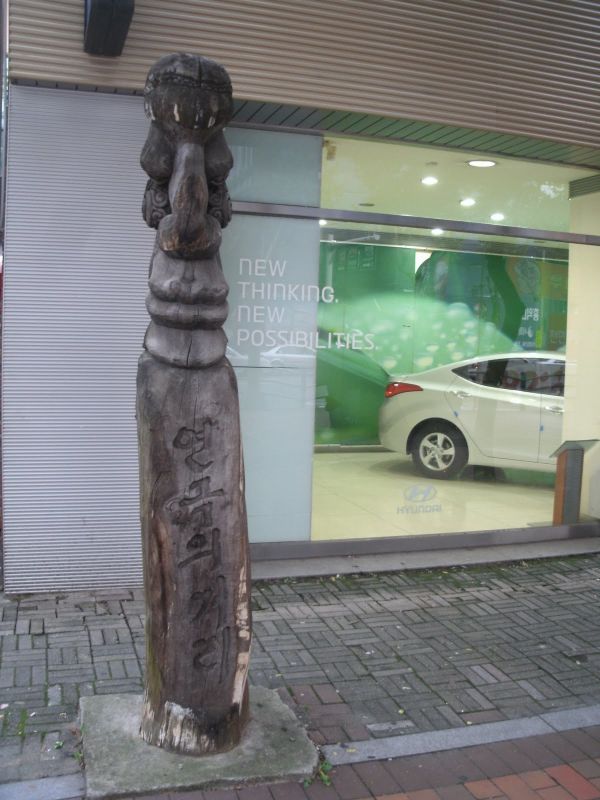
This is a 노래방 (norae-bang, literally “song-room”).
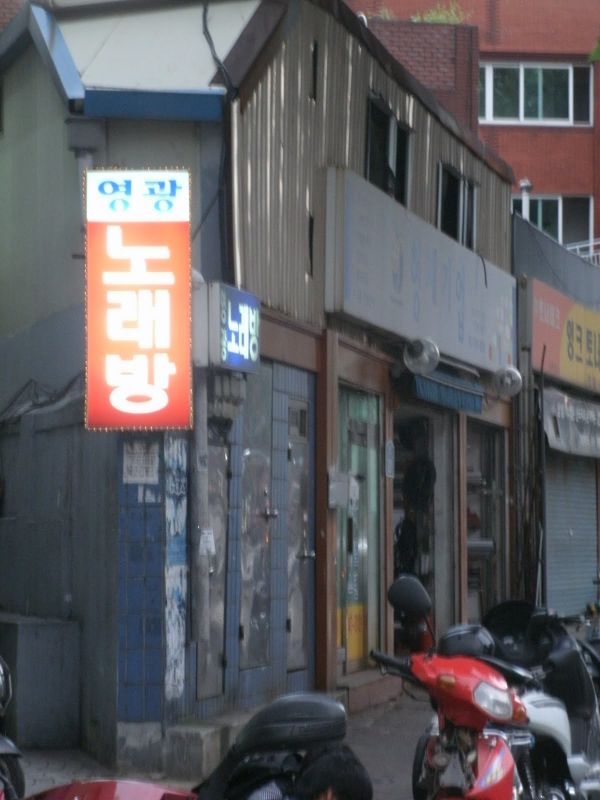
It was the first I had seen, but finding them is not a challenge. Here is what you do in a norae-bang. First, you and your friends go out to several bars and get very drunk on bad beer and 소주 (soju), a traditional Korean potato liquor that tastes like vodka cut with acetone. Beer must be a relatively new thing in Korea, because they have definitely not figured out how to do it right yet. There are two main brands in Korea, Hite and Cass, which you drink because anything imported costs eight or nine dollars a glass. They taste mostly like beer, but also unsettlingly of chemicals. Interestingly enough, Ben told me today that he’s had North Korean soju, and it tastes miles better—it’s the sort of thing that you pour into a wine glass and sip convivially, rather than pounding a shot of it and trying to get the taste to go away as soon as you can. He figures this is because there’s probably still some poor old lady making it by hand, as opposed to however Korea has figured out to industrialize it. Anyhow, the second step in the norae-bang process is that you enter the norae-bang, buy more drinks, and then get a small room with a big screen and a couple books of song names like they have for karaoke in America. You all sing your favorite songs really loud and drunkenly, and all your friends applaud you and make fun of you, and around 4 in the morning, you all stumble home and collapse into heaps.
The norae-bang is staffed, improbably, by a middle-aged lady, who apparently earns her living by staying up all night and selling alcohol and renting out rooms here. You’d think the economic demand for these would support maybe one per neighborhood in a big city like Seoul, and if you were from a small town, why, you’d just have to go to Seoul if you felt like some norae-banging. However, the reality is that in Sachangni, population about 5,000, there are at least three norae-bangs. Korean economics will probably always remain a mystery to me.
Here’s a view of a small part of metropolitan Seoul across the Han River.
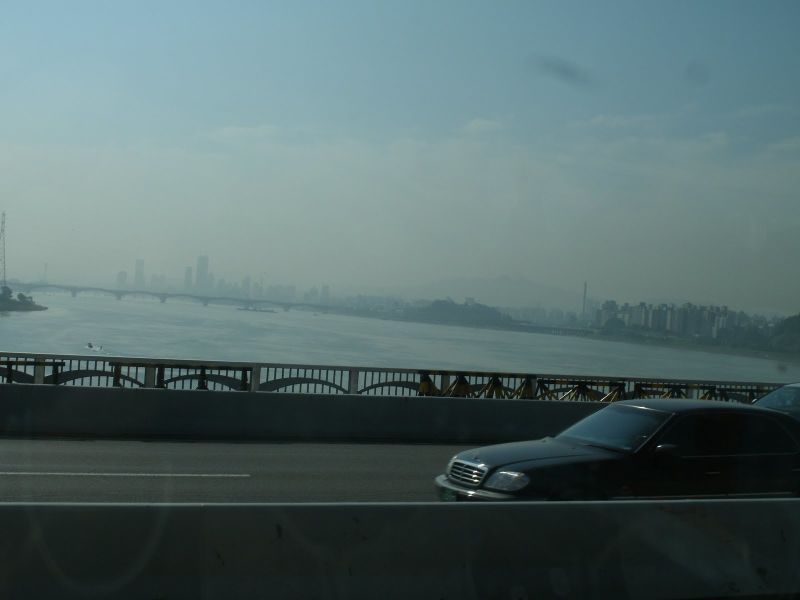
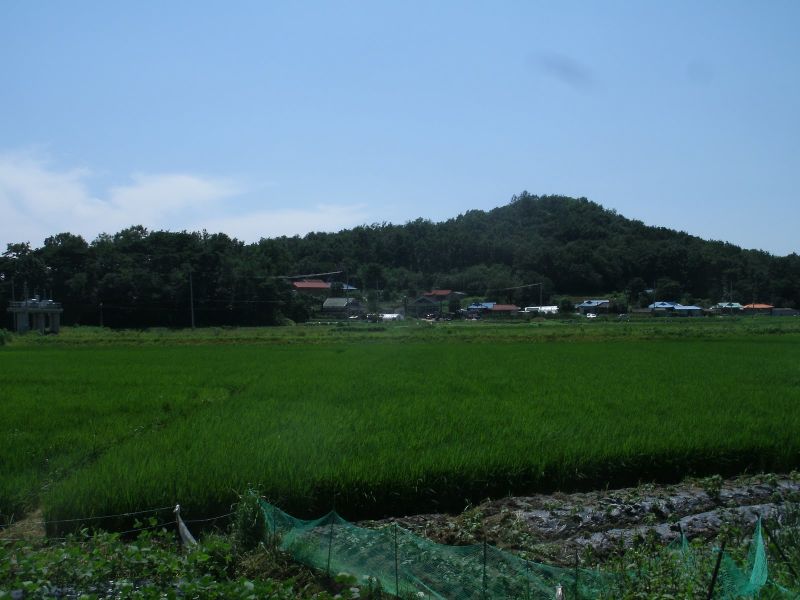
Rice paddy on Ganghwa island.
Next to the rice paddy was this house with a very nice garden out front—they were growing hot peppers, but I don’t think those show in this picture—and I thought, “I’d better take a picture of this traditional house with its garden.” Because we were about to do traditional sedge mat making, I figured we were in a traditional village sort of thing. Later I found out that, besides the cool roof, most of the houses in Sachangni seem to look a lot like this. Everyone has a garden. I don’t think I’ve seen a yard, in the American sense, since I got in the country.
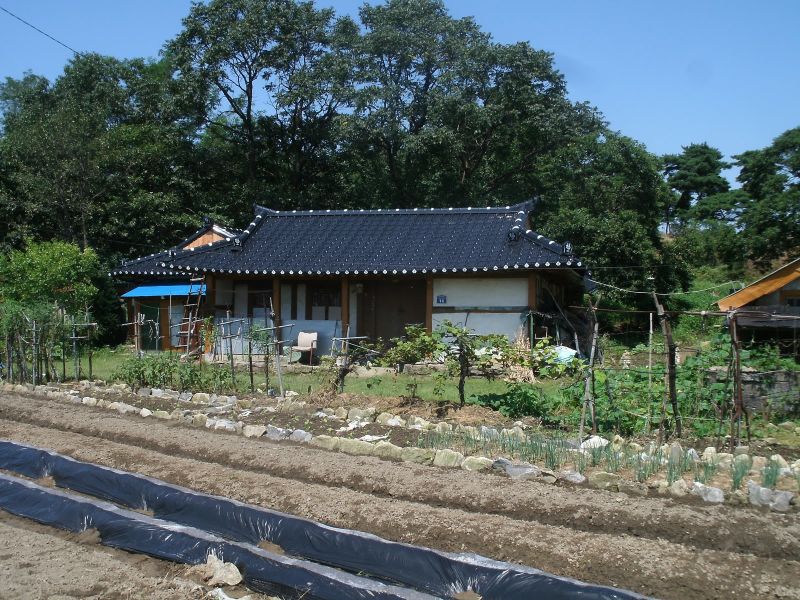
These are the spools with which one makes traditional sedge mats. At the top you can see the four stalks they started me out with.
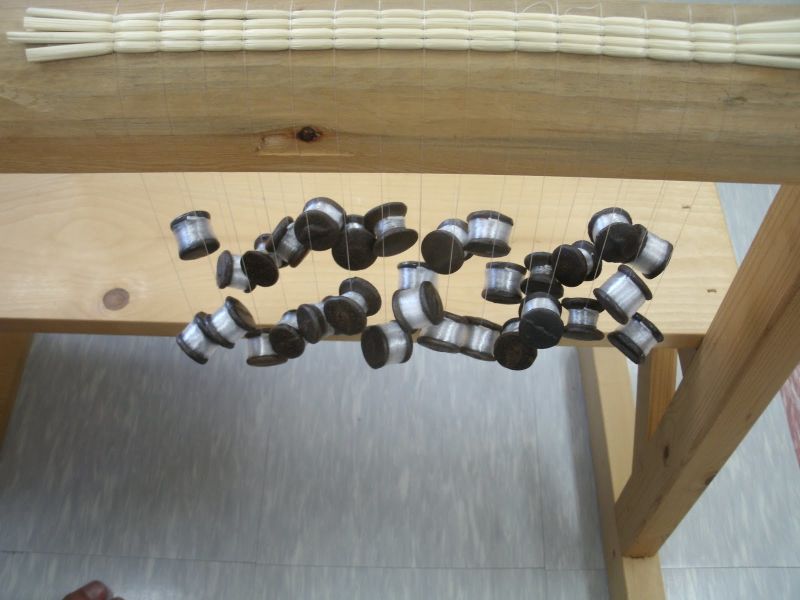
Allegedly if you work at it for a long time, you can make amazing things like this mat, but since we only had about two hours, all of ours were about like the one hanging on its right side.
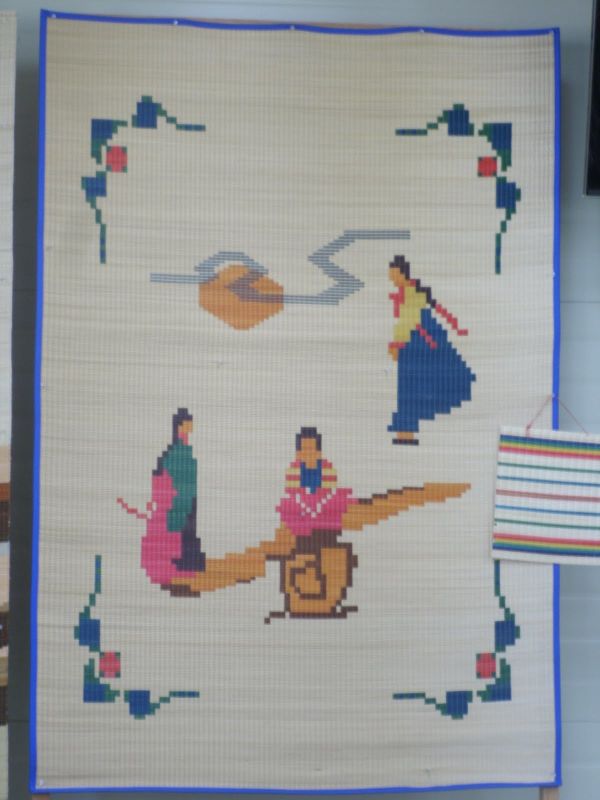
Here’s the dolmen that I mentioned in one of my earlier posts.
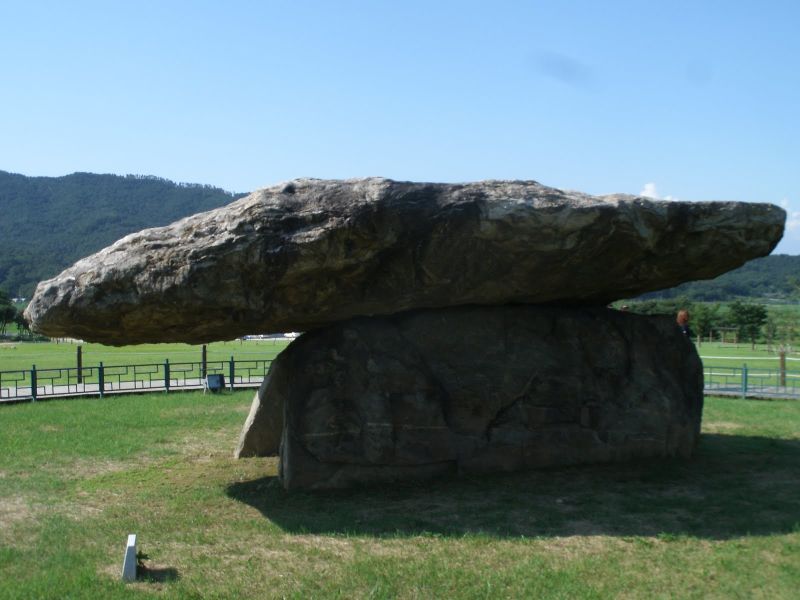
Around the authentic dolmen were some recreations of other old things, Korean and not. I think this moai was made in France.
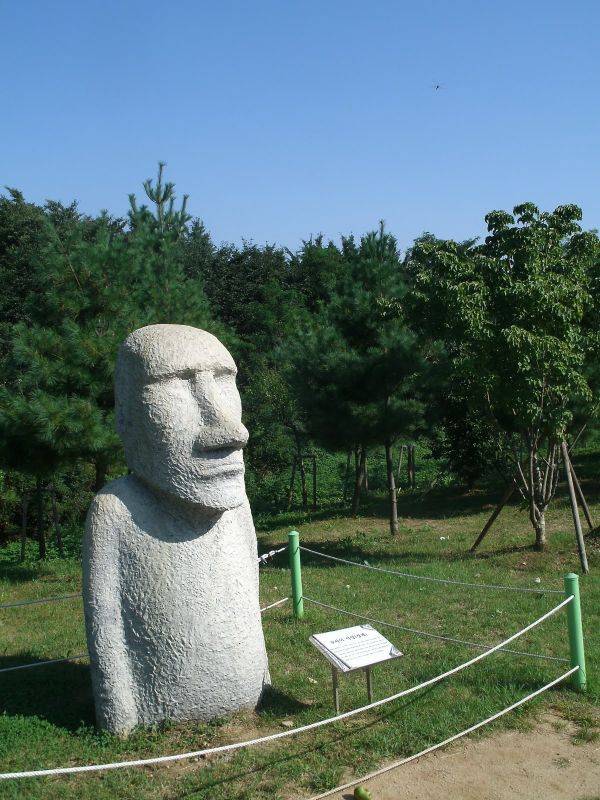
And this, apparently, is what Koreans used to live in about five thousand years ago.
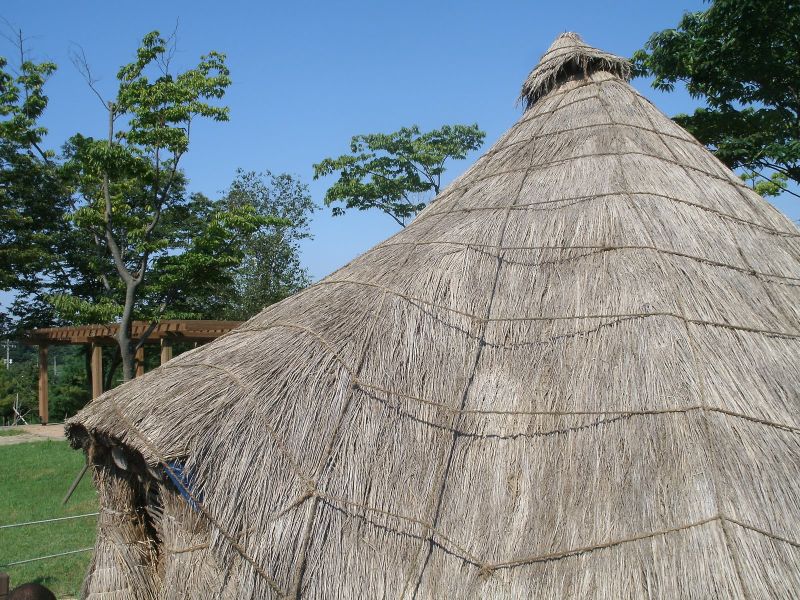
Here are squashes being grown in what I have to assume is the traditional way. But not that traditional, because squash is native to the Americas. They probably didn’t start growing it here until the 1900s.
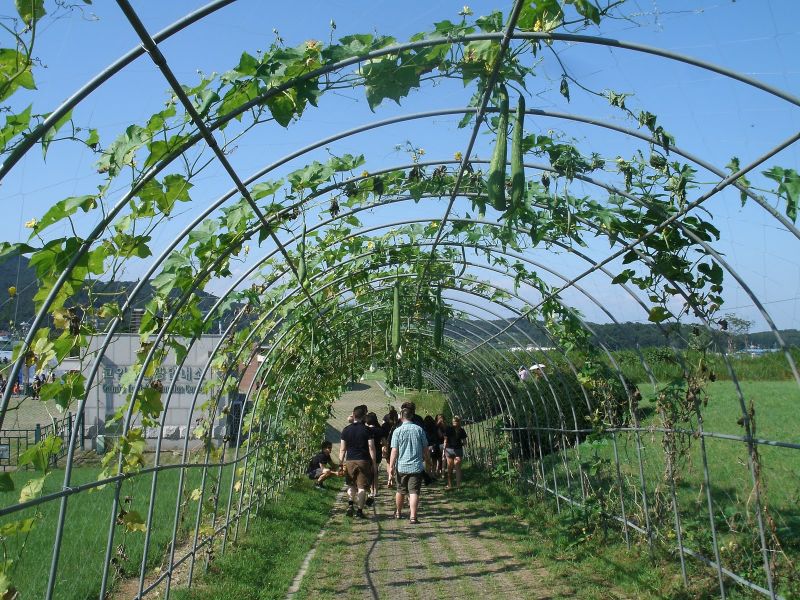
This is a palace grounds we visited, also on Ganghwa Island. The palace isn’t there anymore, but its outbuildings are. I think this one was an archive.
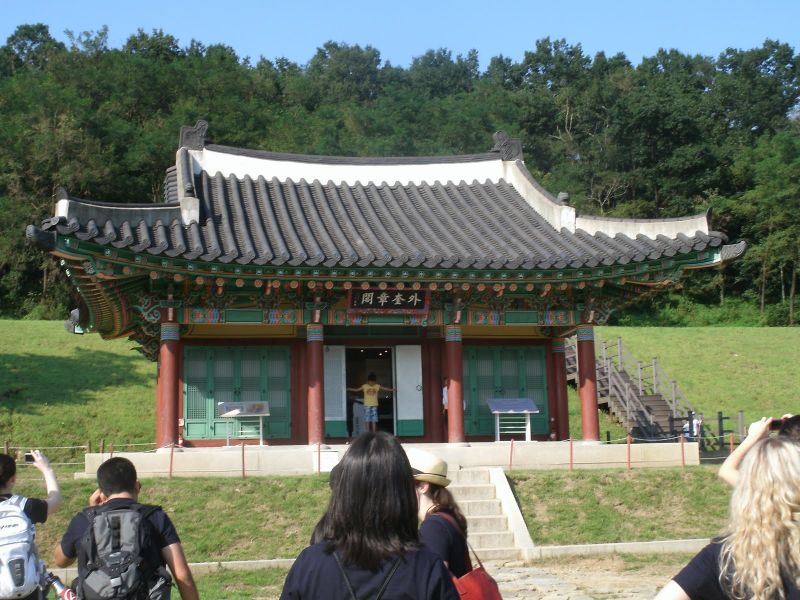
This seems to be what went on in this particular outbuilding of the old palace, except in the old days the people weren’t made of wax.
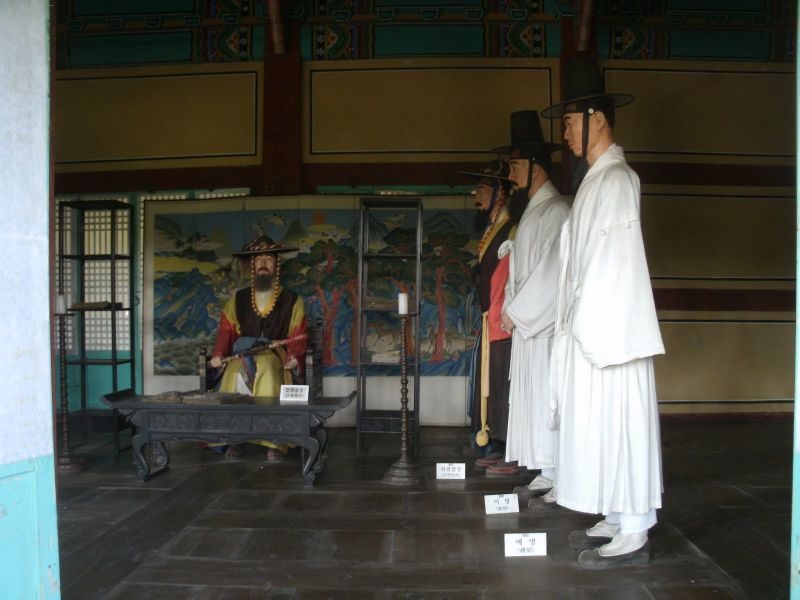
Where the palace used to be, they put a wonderful flower garden.
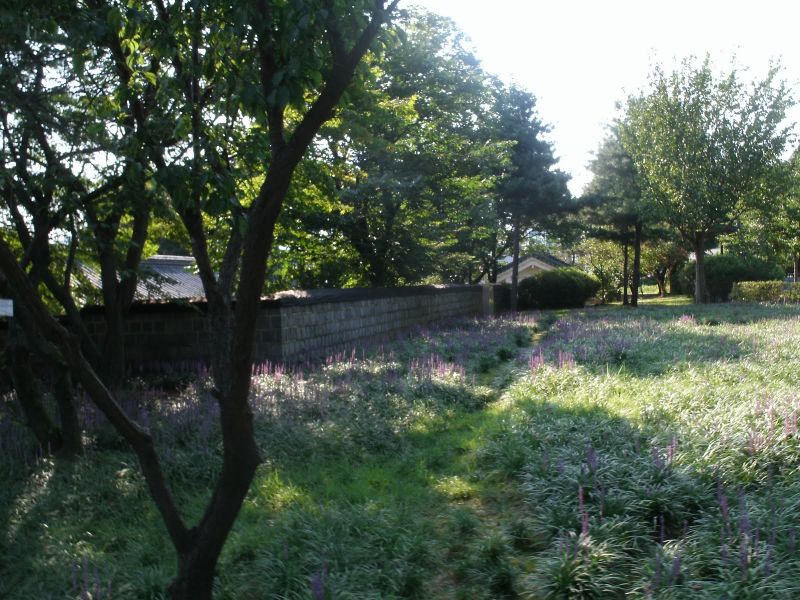
The level of detail in the decoration of this roof floored me. Later I found out that every fancy old building in Korea has a roof like this.
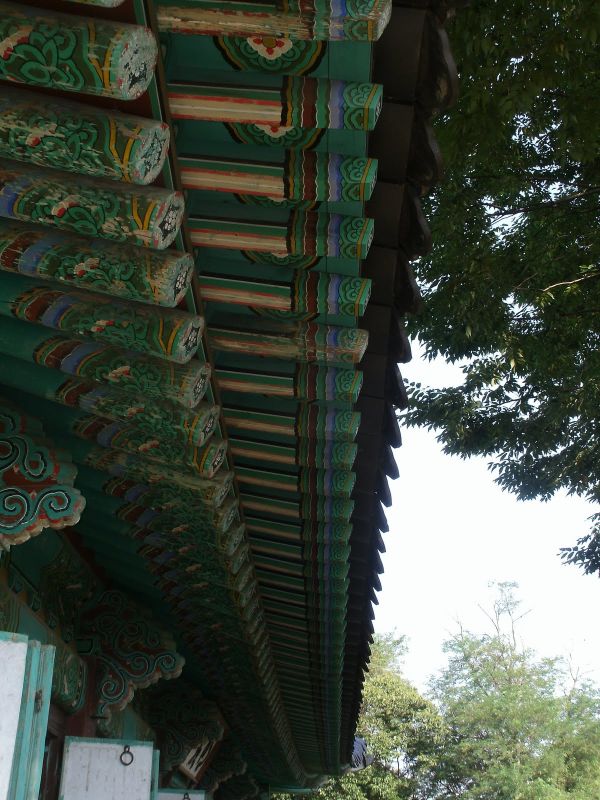
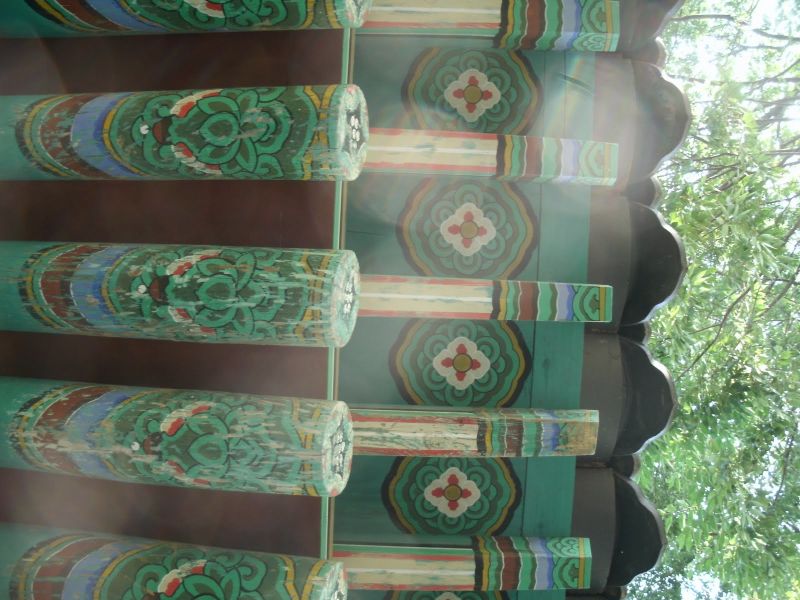
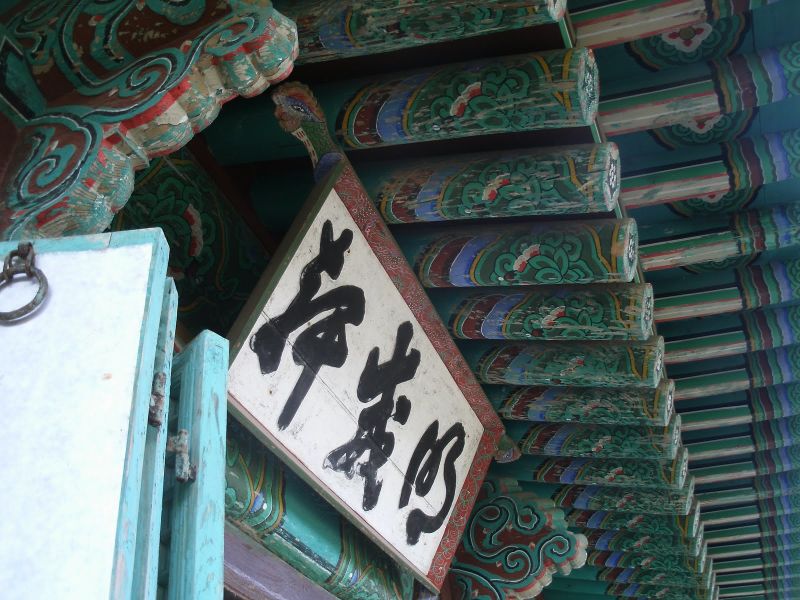
I don’t know where they found the time, but then, Koreans have never been afraid to tackle impossibly monumental projects. To name just two: the Tripitaka Koreana and the Hyundai shipyard. The first one is a series of 81,258 engraved woodblocks from the 1200s with the texts of the Buddhist Tripitaka (sacred texts) on them, millions of characters in all. Each woodblock was carved by a master carver over the course of several days, and the entire project took 16 years to complete. No one has yet found an error in them. They’re so well made and preserved against the elements by such rigorous treatments that they’re still used to print copies of the Buddhist texts today.
They Hyundai shipyard was unlikely, to say the least. The man behind it, Chung Yu-jung, had been working on cars and civil engineering, and had become a fairly successful businessman. Then he decided that shipbuilding should be the way of the future. He had never built a ship before, nor had anyone in Korea really. But he proposed the following idea to several big shipping powers: he would build the largest ship in the world. After getting laughed at for a while, he finally got a yes and a lot of money from one government, but under the condition that he had to build the ship in five years. Unfortunately, he had no shipyard. So he hired lots and lots of men to build the shipyard—and also build the ship at the same time. They worked sixteen hours a day and slept on site. They finished the ship, and the shipyard, two years ahead of schedule.
At the top of Seoul, there is a tower where you can climb up and look out at the whole city.
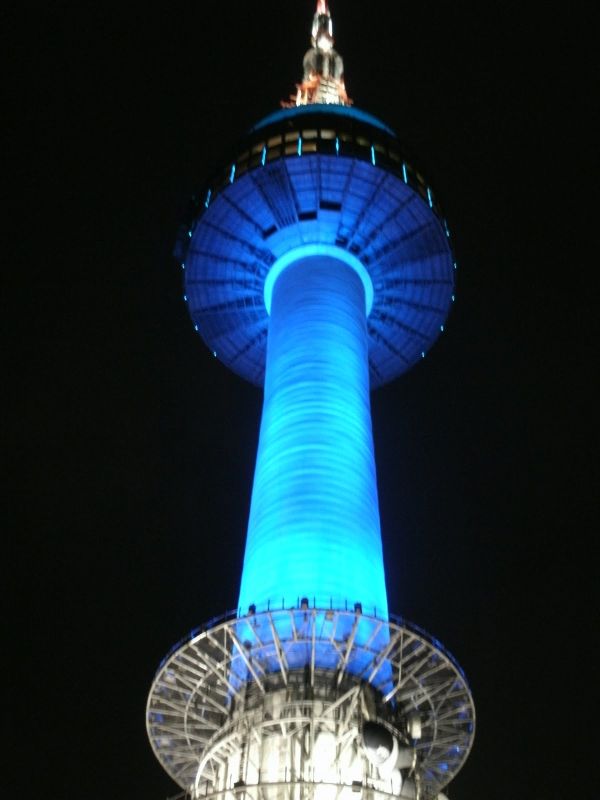
There was a two-hour wait to go up, but down on the ground I was still at the top of Seoul, just not the manmade tippy-top. So I still saw the whole city.
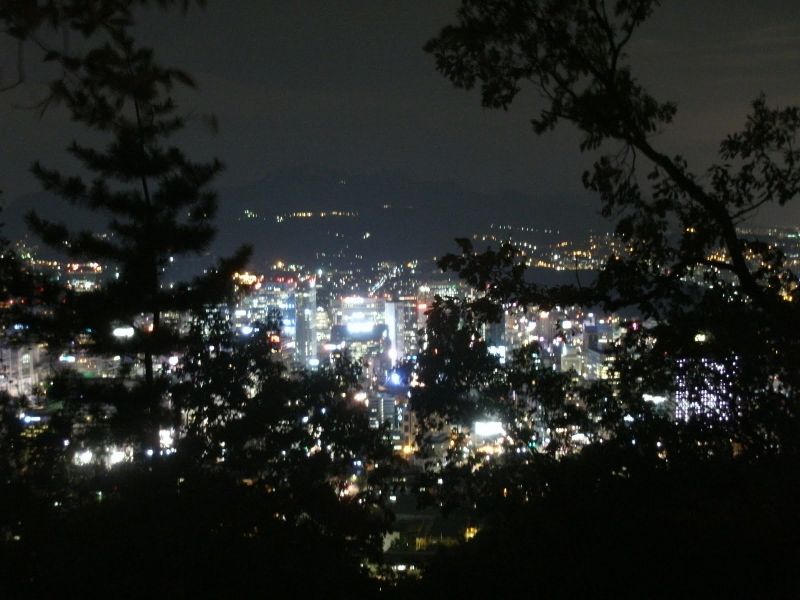
At the bottom of the tower, there’s a boardwalk where you can look out. Of course there’s a railing all the way around the boardwalk. When a couple in Seoul decides they’re in it for the long haul, they come up to Seoul Tower and make out for a long time on the boardwalk. Then they take a padlock, write their love on it, attach it to the railing, and throw the key over the edge. The result is this: thousands and thousands of padlocks.
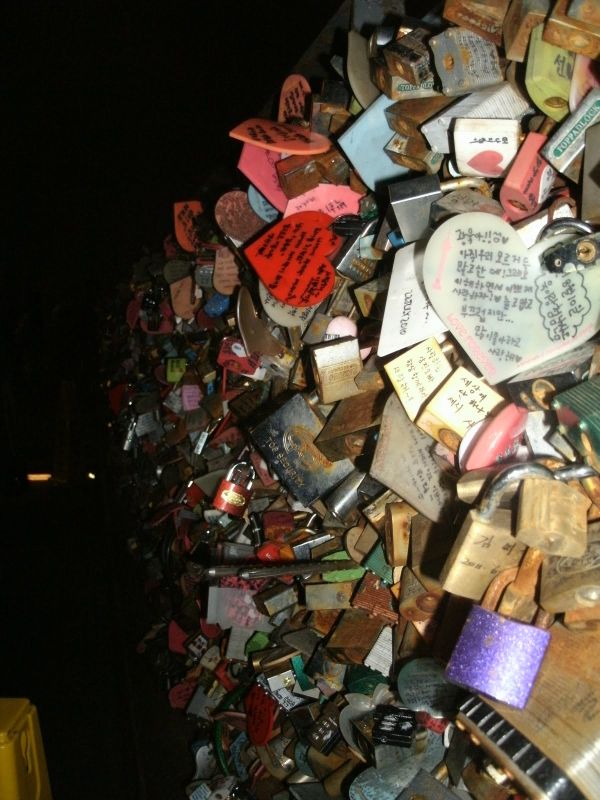
Recognizing that the tower was the most romantic place in Seoul, someone created this monument to romance and put it there.
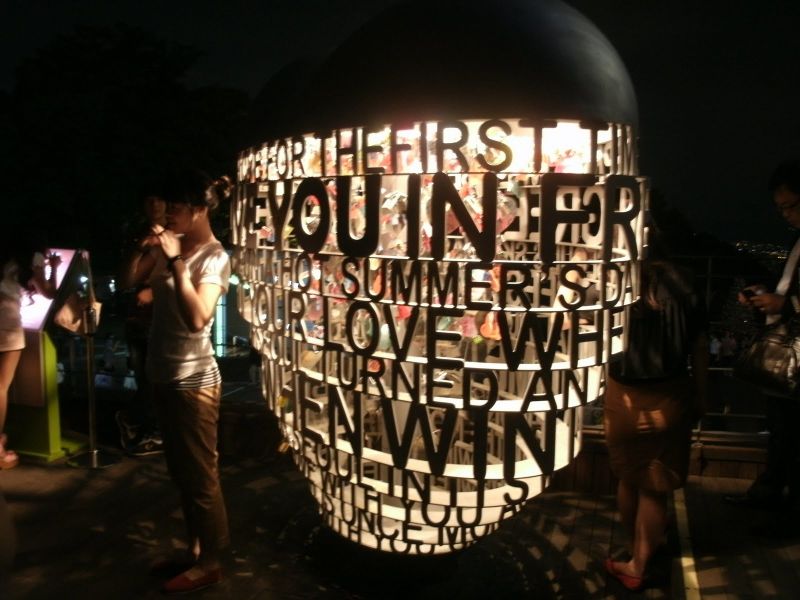
Here I show how adept I am at goofy poses.
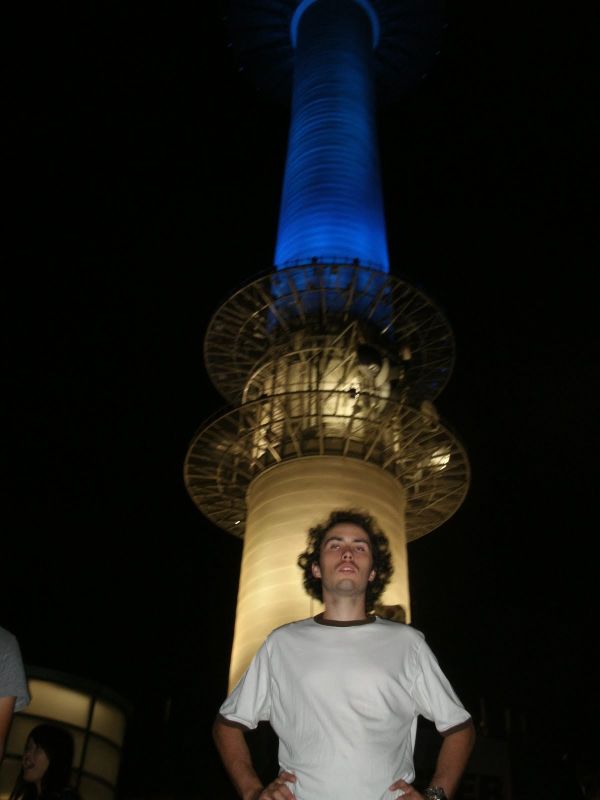
But my friends Alex and Cody are even better. Alex (left) wasn’t even trying.
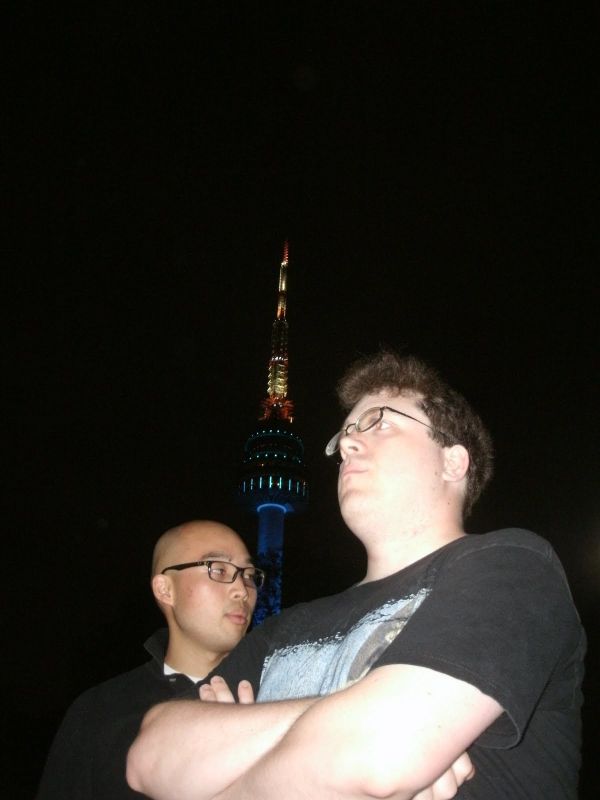
After the orientation in Seoul, some of us found ourselves in the town of Sachangni, these people of course being my new friends. Here’s what Sachangni looks like from our apartment house.
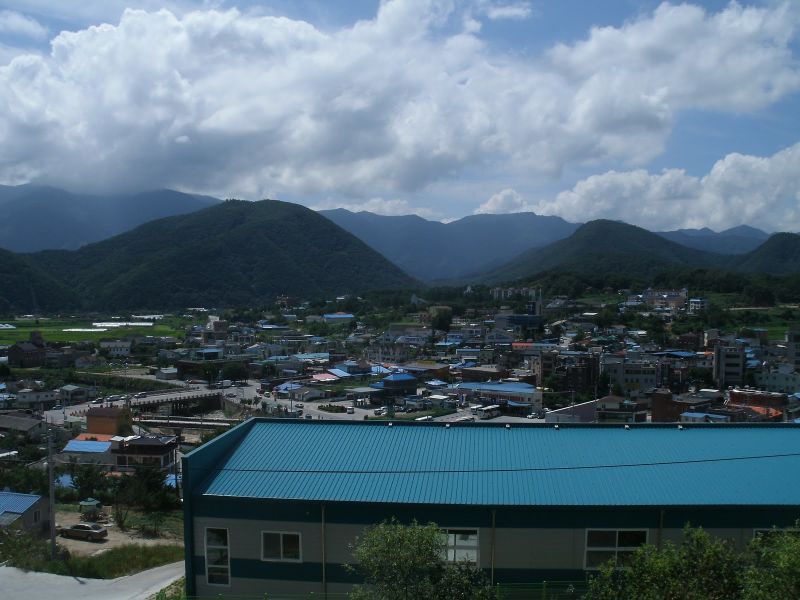
After we’d gotten to Sachangni and settled in a bit, we took a trip to nearby Chuncheon. This picture shows where I had 닭갈비 (dakgalbi) for the first time. I cannot recommend this food highly enough. It’s a simple concept: chicken stir-fried with cabbage, rice logs, some more vegetables that vary by restaurant, and magical sauce. But simple as it is, it’s up there among my favorite foods ever. I don’t know how they make it taste that good. I also don’t know if you can find it in the US—if you can, it must be difficult—but when I come back I’m going to make it all the time. You may have noticed there are a lot of restaurants in this picture, and wondered which one I ate the dakgalbi at. The answer is I don’t know, because every one of these is a dakgalbi restaurant. Chuncheon is the home of dakgalbi, and this is its Dakgalbi Street, an entire alley at least a block long that has only one kind of establishment—dakgalbi restaurants. Furthermore, this is only one of at least three dakgalbi streets in Chuncheon, although I believe it is the only one that has exclusively dakgalbi.
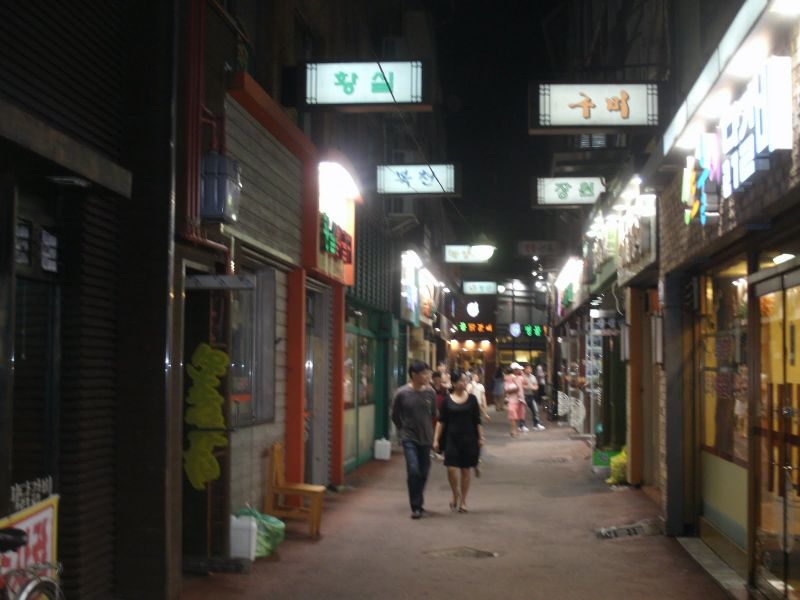
P.S. It can be made with tofu, so you can try it too, Dan.
Next a few pictures from our ascent of 창안산 (Chang-an Mountain). This gazebo near the base is likely where I’ll hang out a lot after I get a bike that I can use to cross town quickly and before it gets too cold to stay outside all the time.
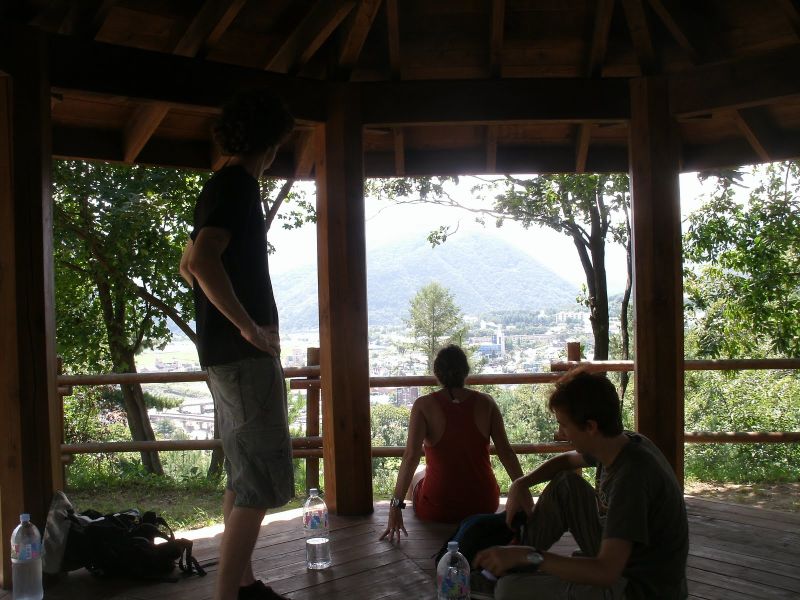
Russell, working out on some of the exercise inexplicably placed on this mountain hiking trail, where I guess they thought people weren’t getting enough exercise.
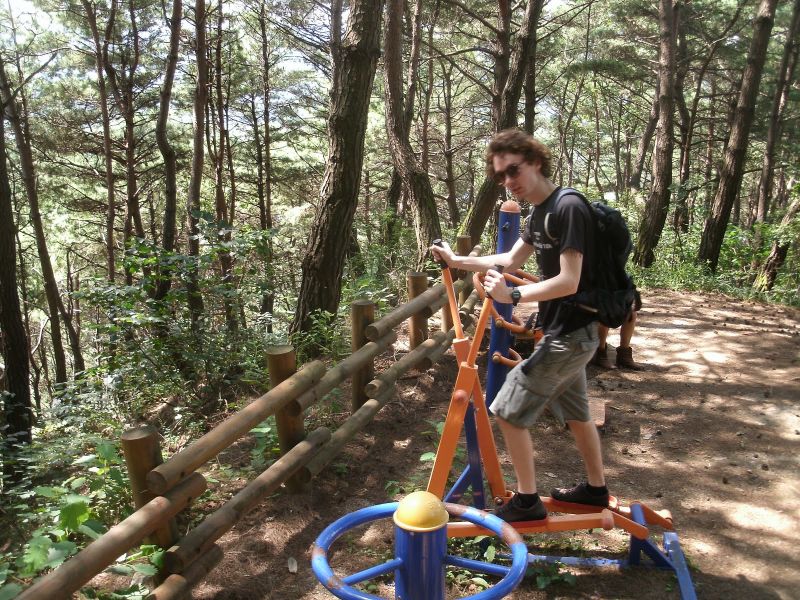
Look closely and you can see Sean climbing up this rock slope. There was an alternative path up the mountain that didn’t make you climb rocks, but that’s for sissies.
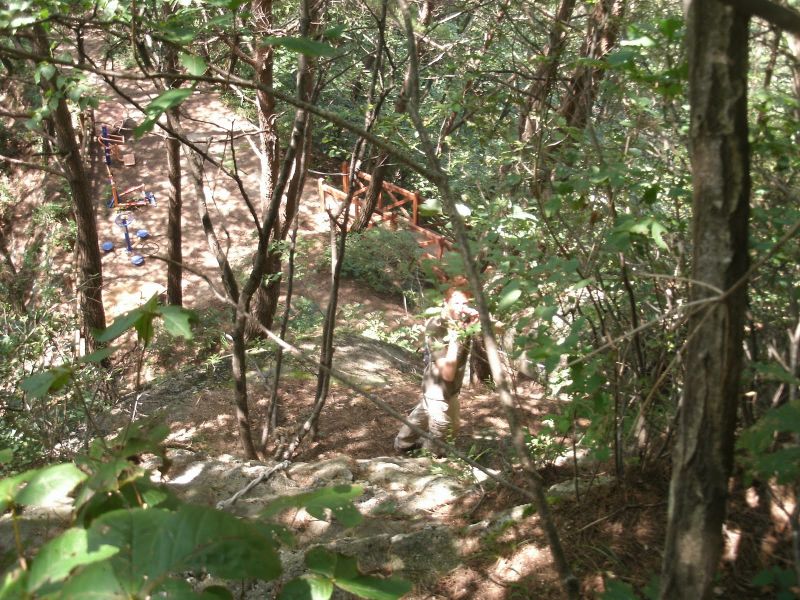
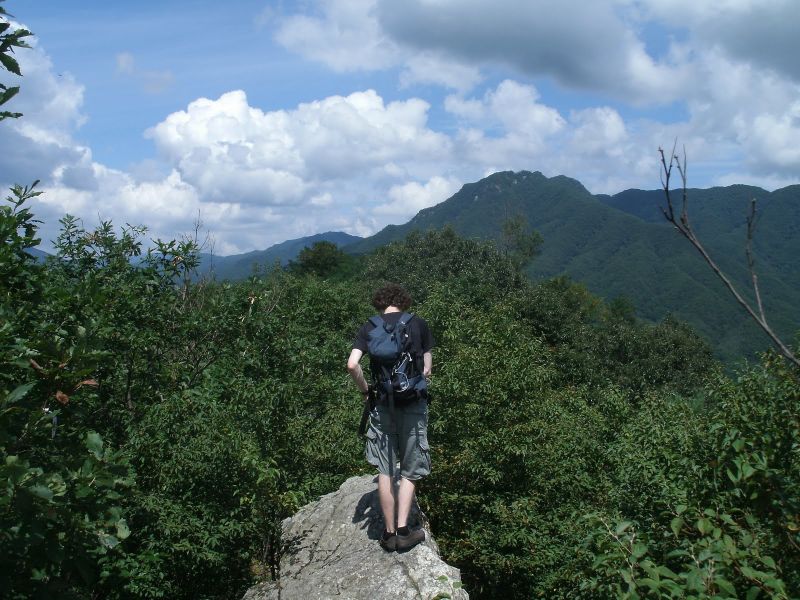
Russell at the peak.
I want to say this is a panorama of Sachangni from atop Chang-an, but actually I’m pretty sure this is the town on the other side of Chang-an. But you get the general idea.

Near the peak we found a couple of these ramshackle huts, whose purpose we couldn’t work out. We figured it probably had something to do with North Korea and our being 12 miles from the DMZ.
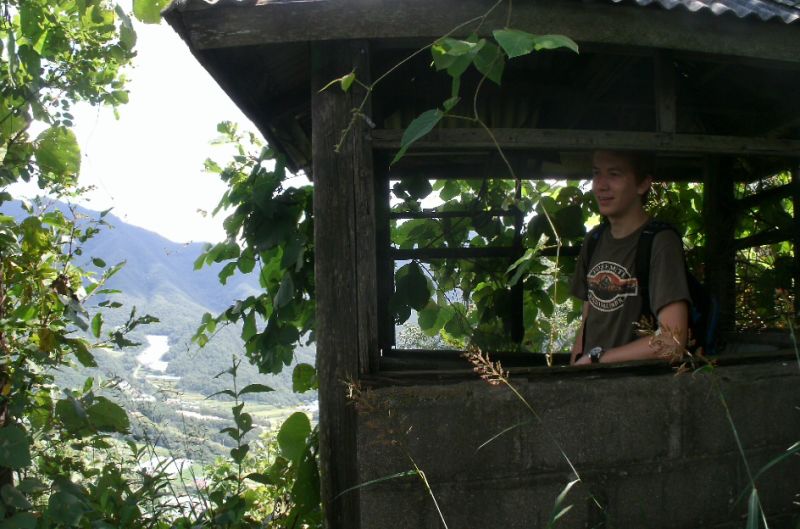
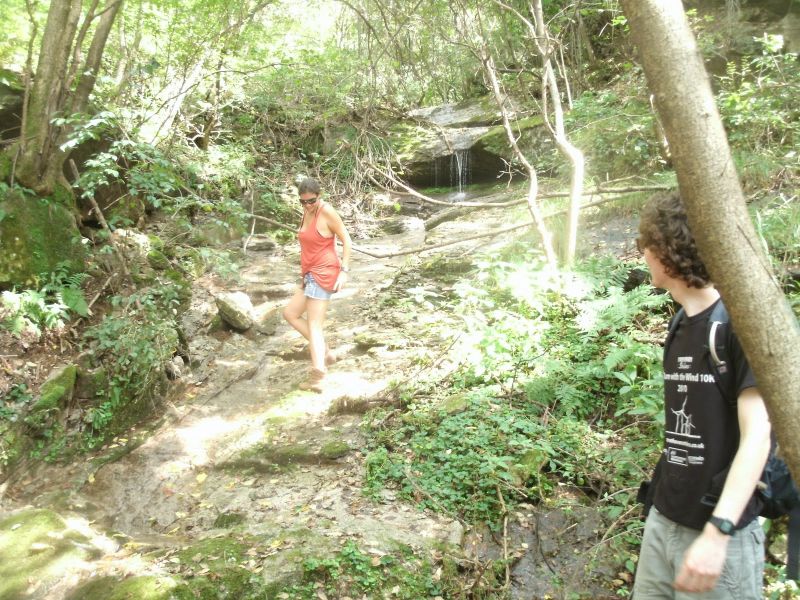
Amanda and Russell on the descent.
I thought Deb might be interested to know we have fire-bellied toads here.
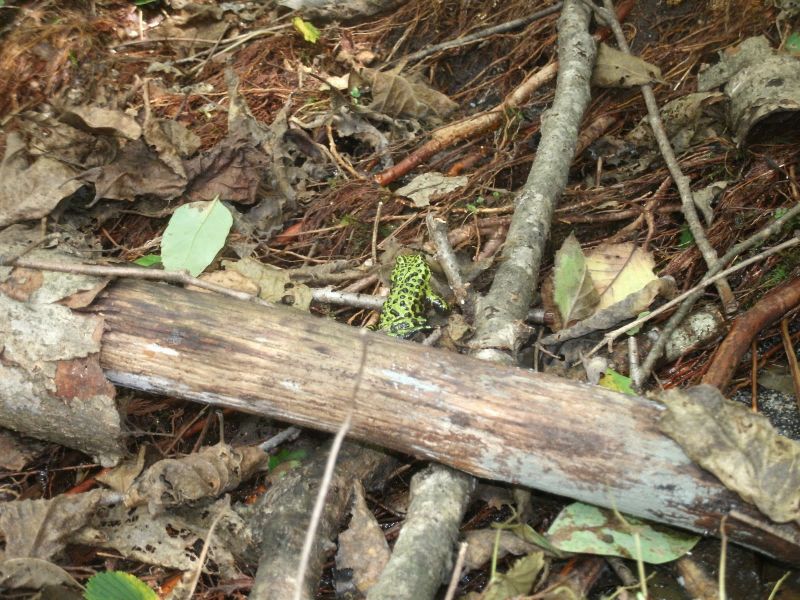
Our descent took us around a rice paddy and then to the river at the bottom of town.
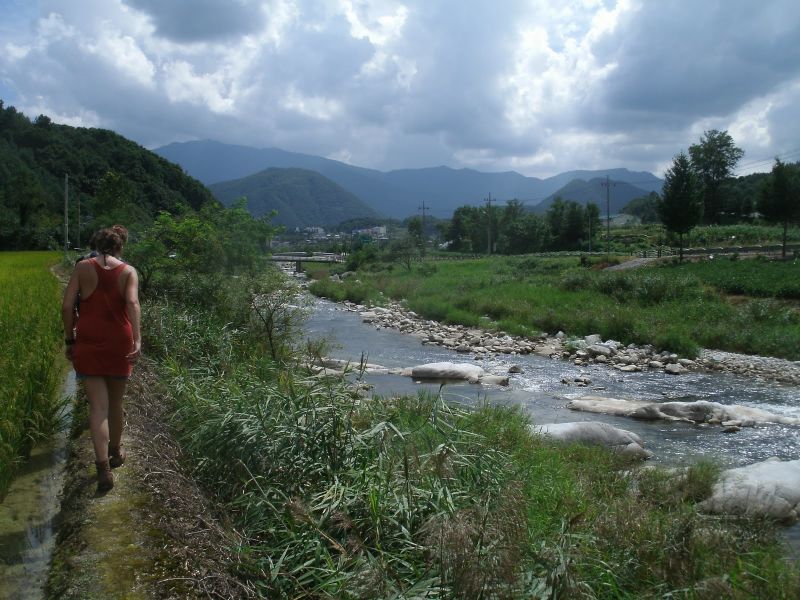
A garden of 깻잎 (kkaennip), which is one of the two leaves you can choose to wrap your dakgalbi in (the other is lettuce). (It’s also one of the few Korean words that’s not spelled phonetically—for some reason it’s spelled kkaes-ip.)
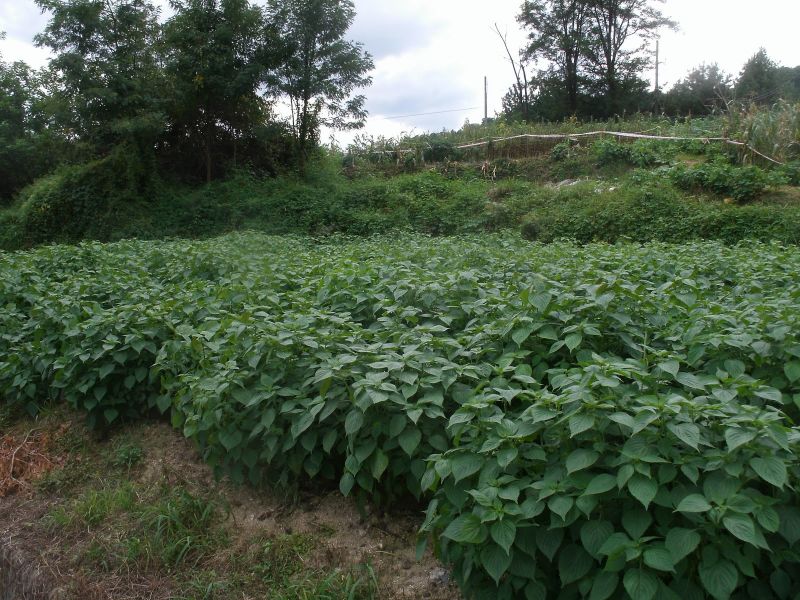
Amanda loves a man in uniform, and at Sachangni’s military festival, she had plenty of them to choose from.
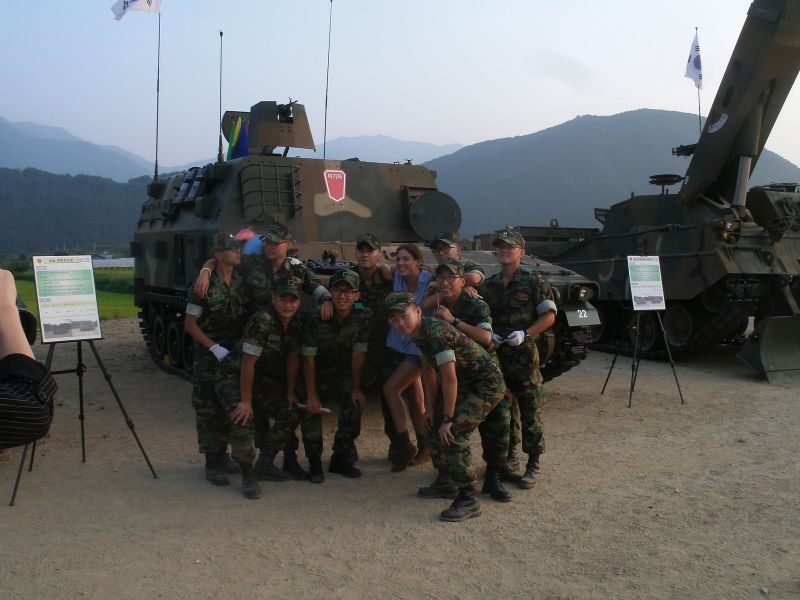
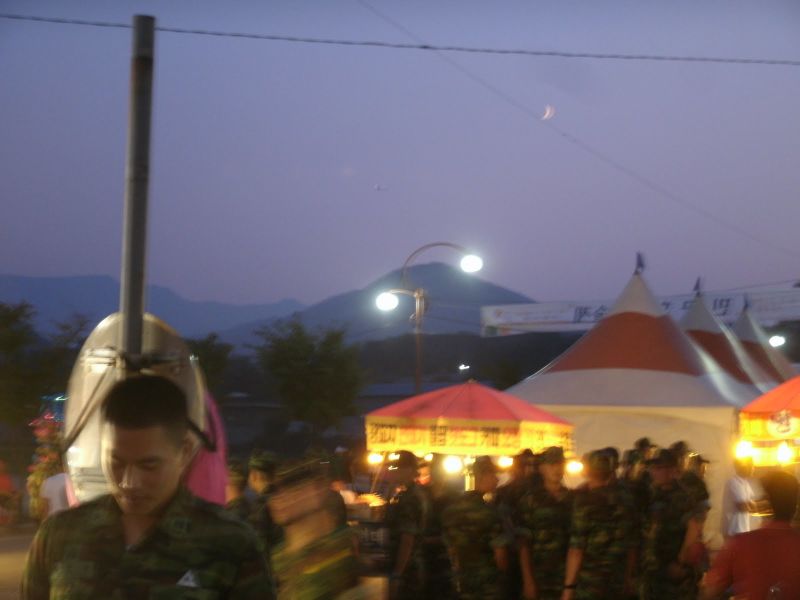
When Korea puts on a festival, it doesn’t mess around. In America no town of 5,000 people could ever muster the energy to put up a stage like this.
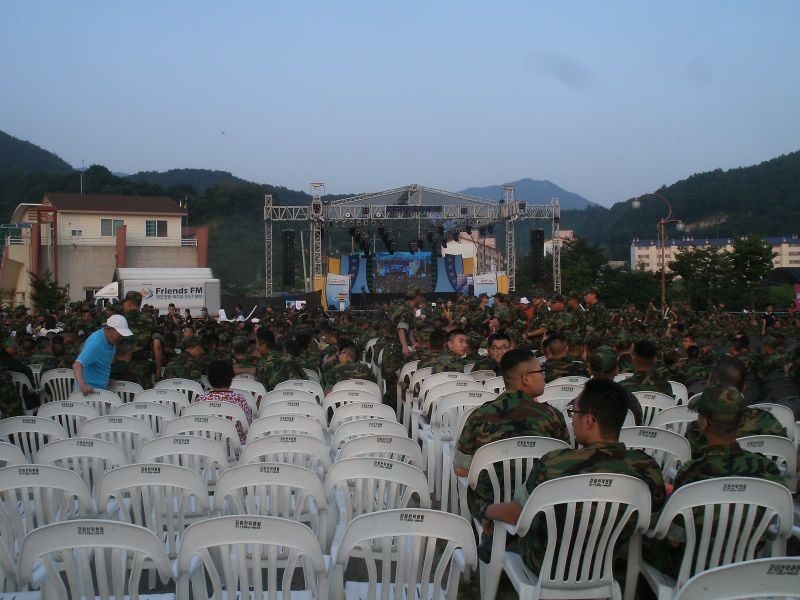
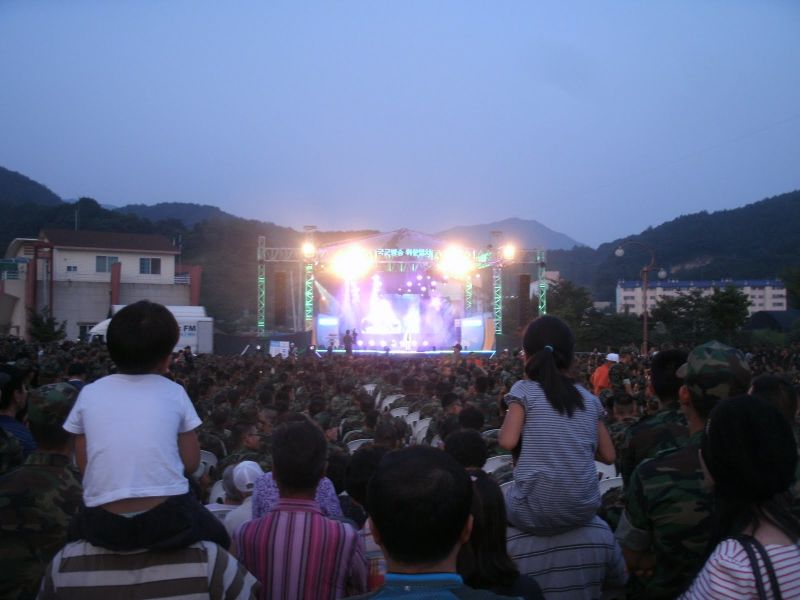
Or a fireworks show like this.
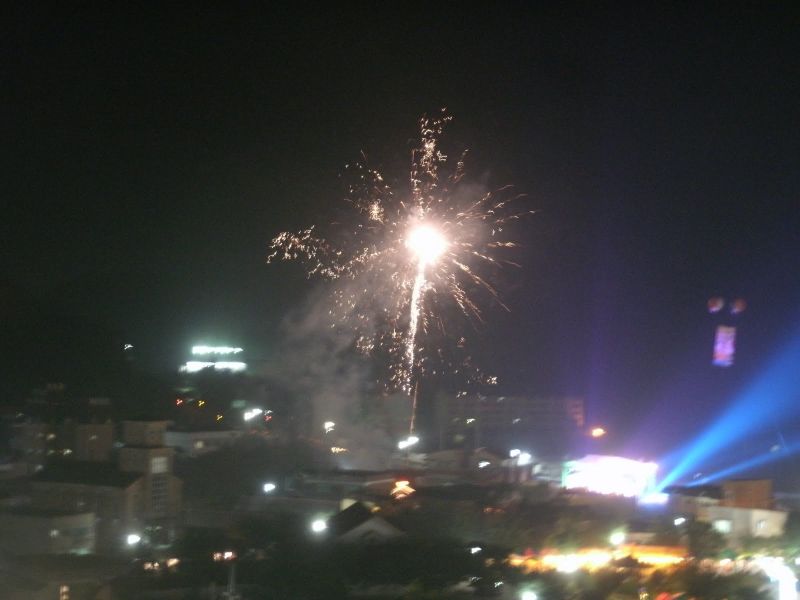
Lastly, a few from our trip to Nami Island. Here: please contemplate if the words “Instant Fish Paste” can describe any possible edible thing.
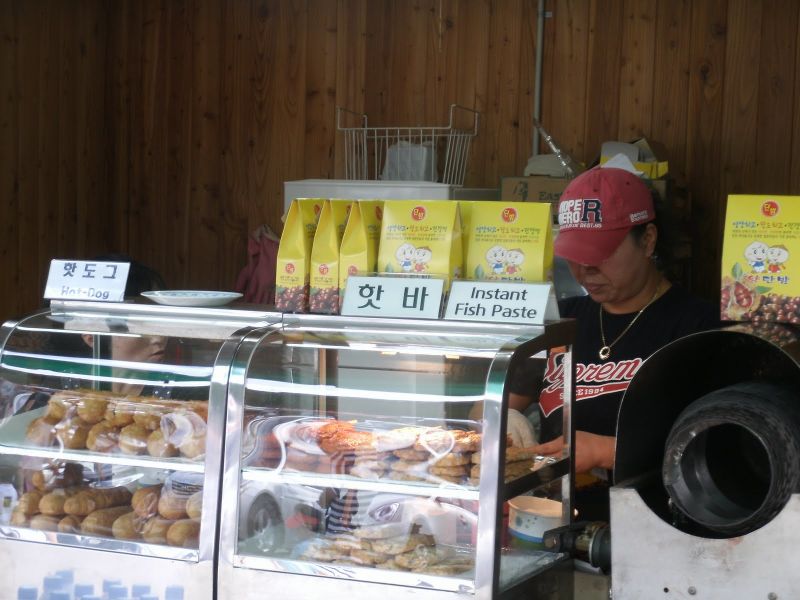
Here we are at the top of the tower that serves as the beginning point of the zipline onto Nami Island.
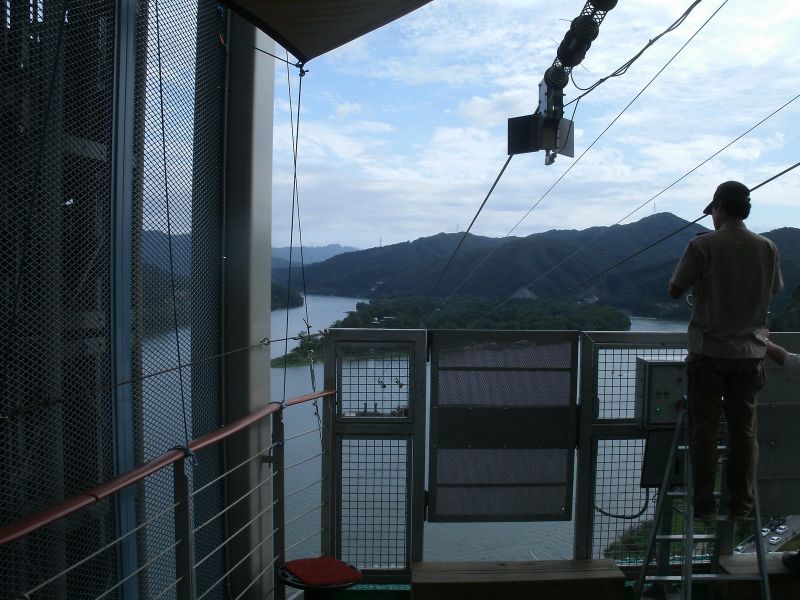
At last a picture of everyone’s faces, instead of all the backs of heads that I usually seem to photograph. This was taken by the zipline operator and it features, from left to right: half of me, Russell, Sean, Amanda, Deanna, and Ben.
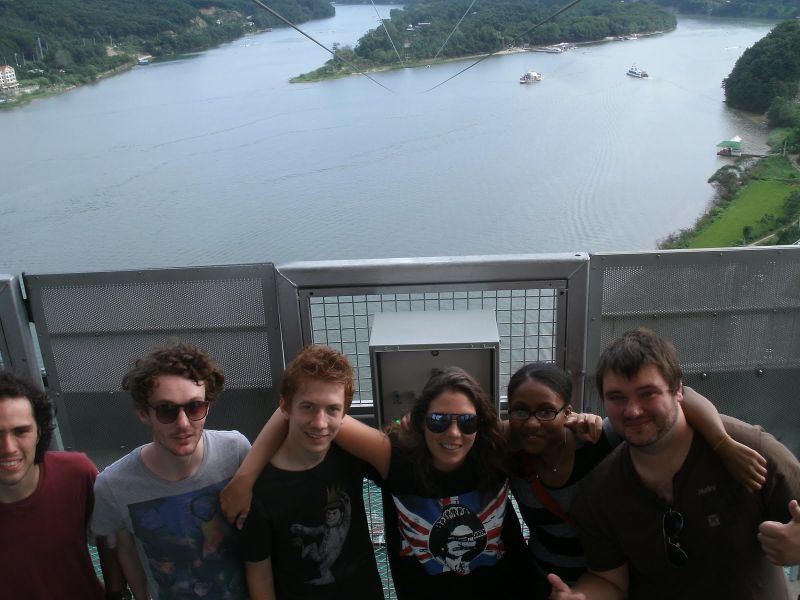
When we landed, it turned out that Nami Island is ruled by ostriches. Deanna unwittingly insulted this one and was subject to a stern reprimand.
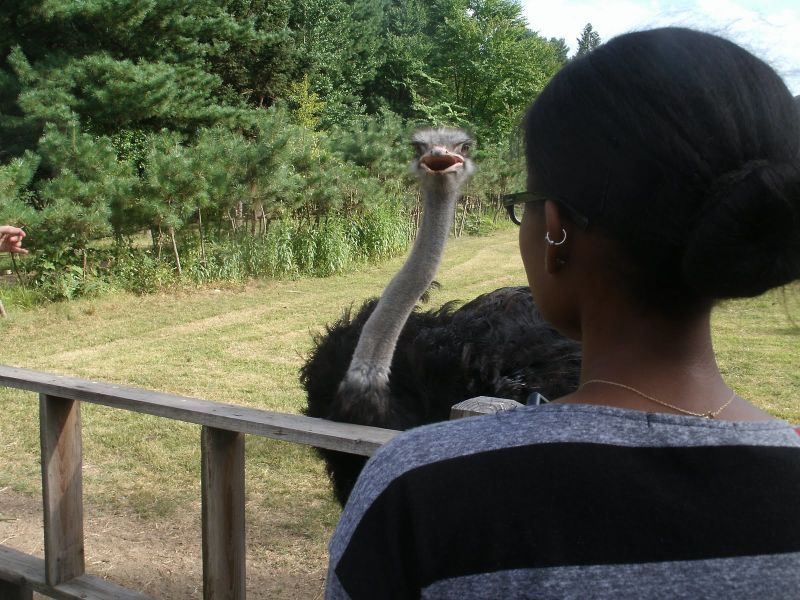
Sean, however, made friends with them. But ostriches can be aloof, and refused to pose for this photograph.
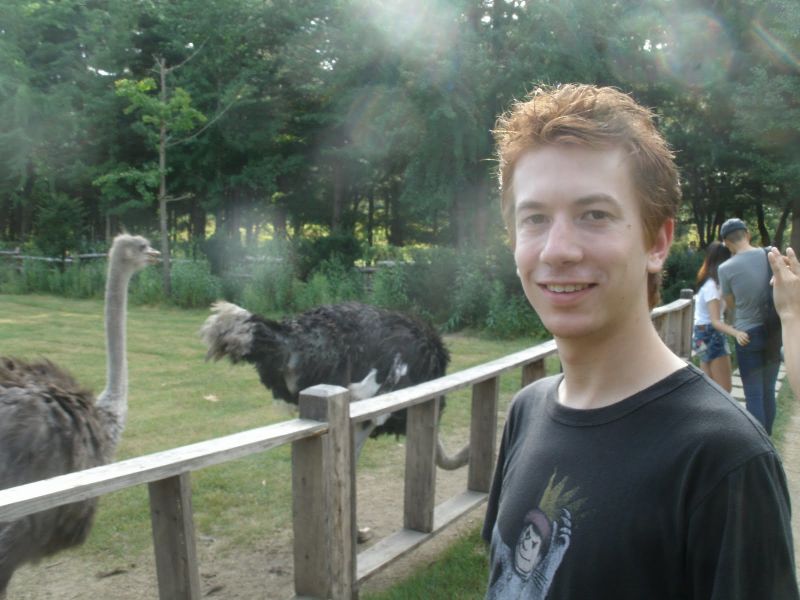
That’s all I have for now. I’ll keep taking them, though.
File under: photos, food · Places: Korea, Seoul
Note: comments are temporarily disabled because Google’s spam-blocking software cannot withstand spammers’ resolve.
7 Comments
Anonymous
HistoryI am stunned by the beauty of the land where you are now living. STUNNED! I need the recipe that you described. Please. Grandpa
Anonymous
HistoryI agree with Grandpa! Those pictures are amazing. Keep them coming. I assume you took the zip line, but no pictures of it?
How about some pictures of your school, too. And maybe of that food you like so well. I will bet if you sent the recipe, if you can find one, we wouldn't be able to find the ingredients. Well, maybe at Jungle Jim's.
It is good to know that you are having such a wonderful experience. Love you. Grandma
Anonymous
HistoryWe are really enjoying your adventure, narrative, pictures and all.
Chuck & Ellen
Oxtrox
HistoryI haven't ever heard what dakgalbi is but I suspect I would like it! I always get a soup at a local (Dayton) chinese restaurant that is owned by Koreans so it has a special Korean menu (in Korean text, well characters) called "jam-pong". According to the guy I used to work with that introduced it to me, It's like cheeseburgers in America… you can get it anywhere.
Regardless, I will be disappointed if you don't really take note of the cuisine over there and bring it home. with my dietary limitations, I am always in need of more seafood based chow. Or tofo, hehehe
Anonymous
HistorySo, a new question. Do you have a telephone number. Land line or cell or both. Might call you around the holidays. Send it via e-mail. Grandpa
Anonymous
HistoryTruly fascinating! :) MOM
Chuck
HistoryI've actually never had jjamppong. If I had to pick something that's like cheeseburgers, it'd probably have to be kimbap—rice rolls. They look like sushi, but instead of fish in the middle, they have pickled radish, various long veggies, and usually either ham or tuna, though you can also make them with kimchi. Or maybe tteokbokki, which is rice logs and squares of pounded fish in hot red sauce. I'll keep an eye out for jjamppong, though. I'm not a good person to tell you about seafood stuff yet, because I've kind of been avoiding it so far, but I think over the course of the year I'm going to try to build myself up to be a fish person. Like, someone who eats fish, not—someone with gills. Sean is a huge fish person (that is, he's a very tall person with gills), and he's trying to persuade us all to go out tonight for hoe, which I think is something like sushi (and pronounced hweh—don't know if you all memorized my Korean pronunciation guide back in August), so I might go along and try that out.
I don't have a phone number, but you know what I do have, is Skype. This is a program that you can download for free from skype.com, and then you can use it as a phone for totally free, plus you can also have video chats, also totally free. That's what I'd figured on for Christmas—a video chat, so I can see all of you and you can see me.